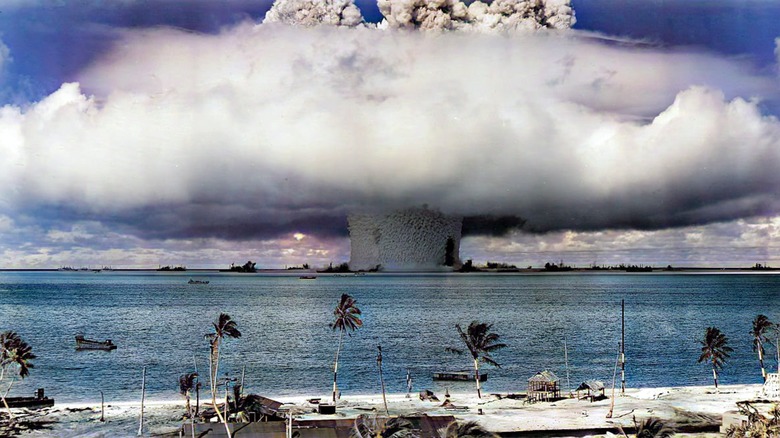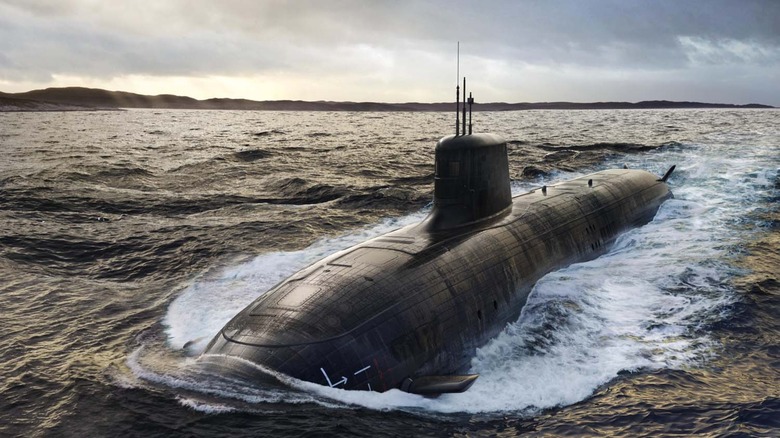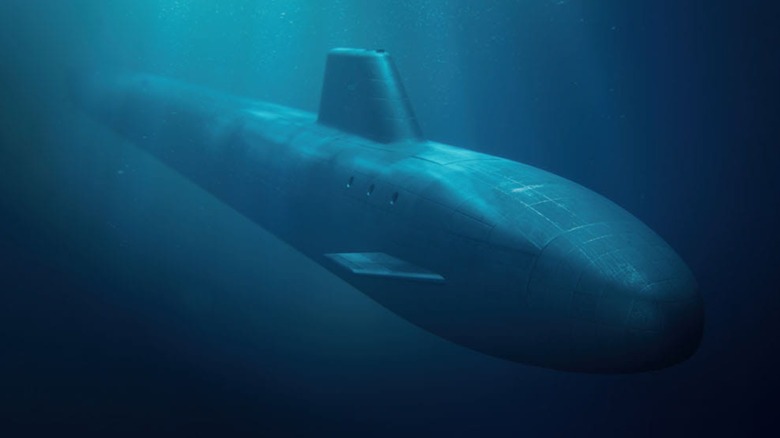Can A Submarine Survive A Nuclear Attack?
Nuclear weapons produce frighteningly massive detonations that destroy everything in their path. They've only ever been used once during wartime, and the bombs of today are even deadlier than the one the Enola Gay dropped on Hiroshima in 1945. Nuclear weapons have gotten more complex; they have significantly higher yields, and they're capable of causing widespread destruction. They've been tested in all manner of environments, including atmospheric detonation, in space, on land, underground, under and on the surface of water.
Because large formations of ships, like Aircraft Carrier groups, are targets of nuclear weapons, it's interesting to consider what might happen to any vessels operating beneath the surface. Modern nuclear submarines, like those serving numerous navies around the world, are some of the most sophisticated military machines ever produced, and believe it or not, they've been designed to withstand nuclear blasts. Of course, there are many caveats and numerous factors to consider, including explosive yield, where precisely detonation occurs, and the sub's depth.
If a bomb or nuclear-armed torpedo were to strike a submarine directly, it wouldn't survive, but the U.S. Navy and others around the globe have tactics in place to combat the threat. Doing so requires a great deal of training and no small amount of luck because of the nature of submarine nuclear detonations. Most likely think that diving as deep as a sub can go is the best strategy, but it's actually the worst move imaginable. The current practice is to rise to periscope depth and ready the sub in the same manner as is done for depth charge attacks.
How submarines are threatened by nuclear detonations
When a nuclear detonation occurs beneath the surface of the water, several things happen almost instantaneously. The most lethal spot to be in is directly beneath the blast because, when detonated underwater, the burst spreads conically toward the sea floor. Submarine depth limits wouldn't help in these situations and would only further endanger the crew. This is because the blast wave creates significant overpressure that no submarine is designed to survive.
Some might think that using stronger materials in a submarine's hull would provide more protection, but the U.S. doesn't build its subs with titanium hulls. Because of these concerns, the last thing a submarine captain would do is tell their crew to dive. Instead, they rise to periscope depth (up to 60 feet) and then set an evasive course at maximum speed. The course would be upwind of the detonation if it were to fall downwind to avoid fallout. If the submarine escapes the initial blast and avoids fallout as much as possible, the water would insulate it from significant damage.
Seeing as nuclear war likely means the end of civilization as we know it, there is an advantage to being on a nuclear submarine. There's even a scientific paper about using them as life rafts for humanity because of their endurance. A modern nuclear submarine can remain submerged for months at a time and only requires returning to the surface to reprovision. Many nuclear submarines can remain at sea for years if provisions are delivered to them. In a so-called "shooting war," nuclear submarines are likely the safest places to be.
The advantages of nuclear submarines in a shooting war
One of the reasons that nuclear submarines, like the Ohio-class used by the U.S. Navy, is so difficult to locate is largely because of tactics and the challenge of finding submerged vessels. They purposefully avoid detection because some of them carry their own arsenal of nuclear missiles. Should the need arise, they move towards the surface and fire at their targets. At this point, they can be located, but before anyone could retaliate, they'd quickly move far out of the way.
Modern nuclear submarines all have this advantage, and in the U.S., nuclear-armed subs make up a third of the nuclear triad. Nuclear testing in the 1950s found that a blast would need 700 lbs. per square inch (psi) to damage a submarine's hull. Contemporary subs would likely survive 1,500 psi, and a one megaton blast at a distance of 2.25 miles underwater would produce that much psi. A one megaton blast is about 67 times that of the Hiroshima bomb.
In theory, a nuclear submarine can escape the blast, move out of the area, and return fire. It could conceivably do this until all of its missiles are spent. Since Ohio-class nuclear submarines carry 20 Trident II D5 submarine-launched ballistic missiles (SLBM), they can cause widespread damage to the enemy. Subs have been designed for this purpose. Even if an enemy gets lucky and strikes near one, there's still a good chance they'll survive to return fire.


